Abstract
A previous report demonstrated that endothelial cells have erythropoietin receptors and respond to this hormone with enhanced proliferation. The present study demonstrates the existence of mRNA for erythropoietin receptor in human umbilical vein endothelial cells. We have reverse transcribed mRNA of endothelial cells and then used different PCR primers to amplify erythropoietin receptor target cDNA between exons 5 and 6 as well as 3-5 in addition to an internal standard DNA fragment. Correspondence of size as well as location of restriction endonuclease scission (Ava II) was used in comparing the amplified fragments of human endothelial cell erythropoietin receptor to those of two human erythroleukemia cell lines, OCIM1 and K562. No alpha- or gamma-globin mRNA was detected in endothelial cells but was readily demonstrable in OCIM1 cells. In addition, to determine whether the expression of human erythropoietin receptor on endothelial cells occurs in vivo, sections of umbilical cord and placenta were immunostained with antibodies against the extracellular portion of the receptor; the results showed strong positive staining of the vascular endothelium.
Full text
PDF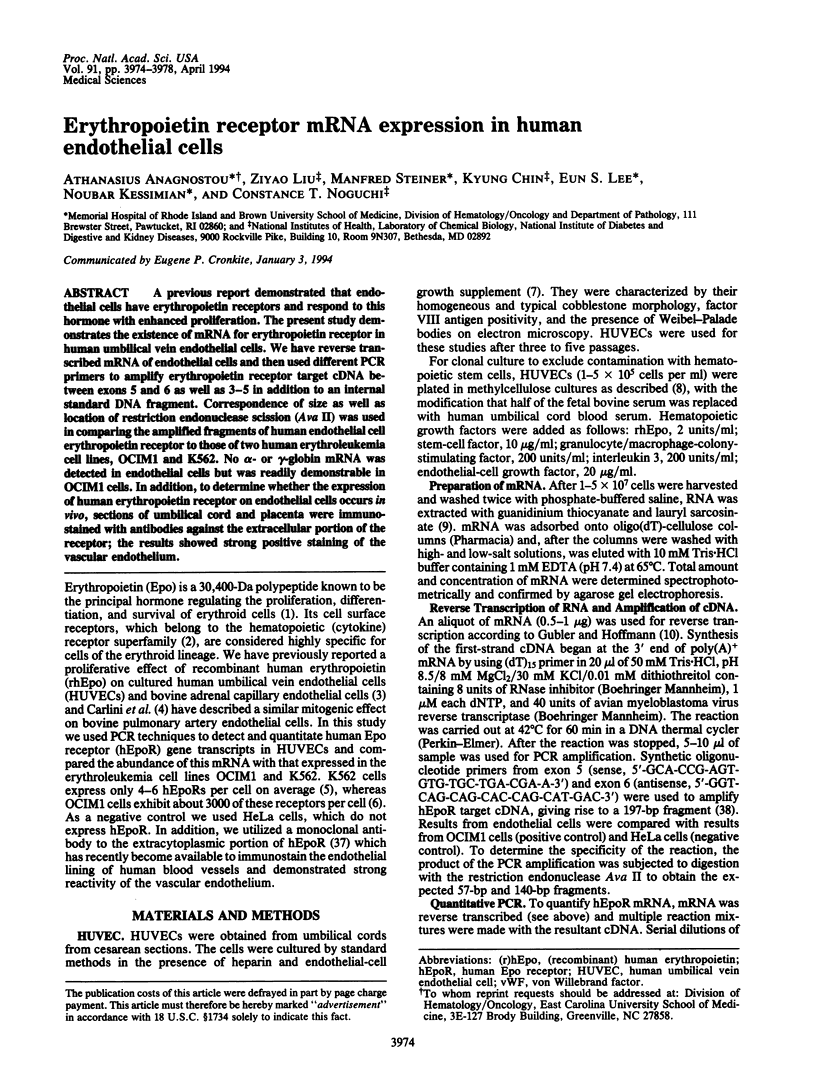
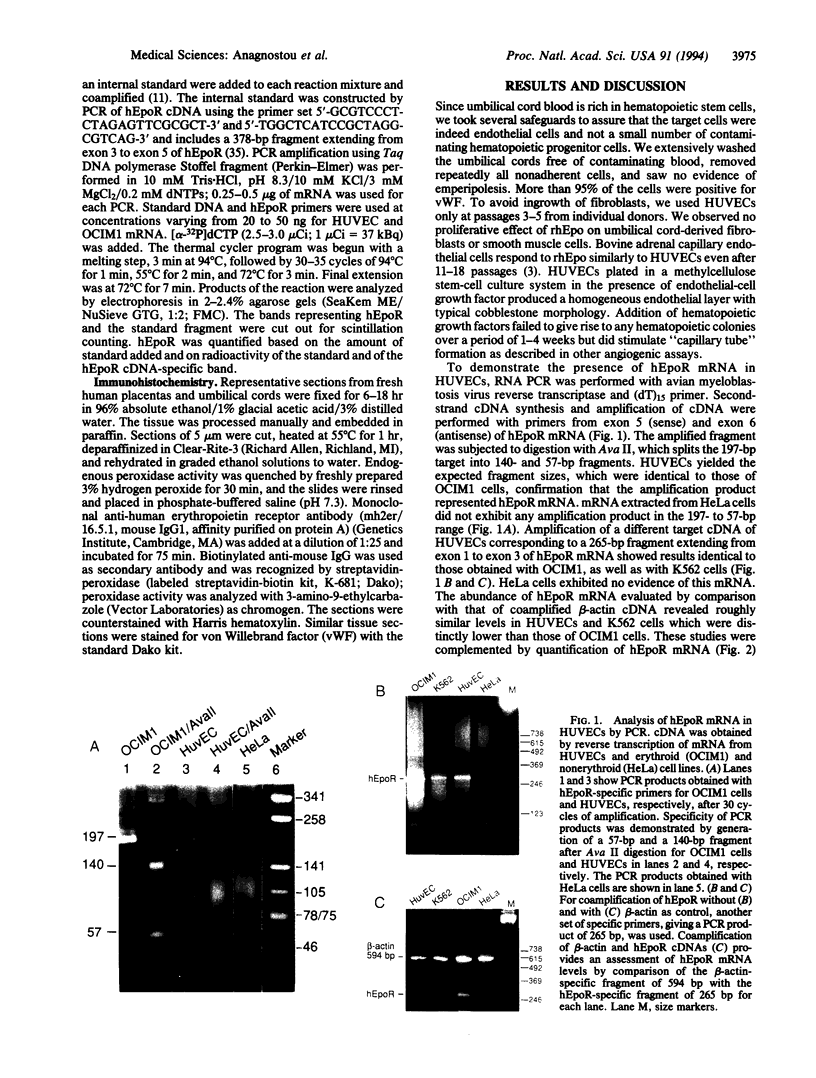
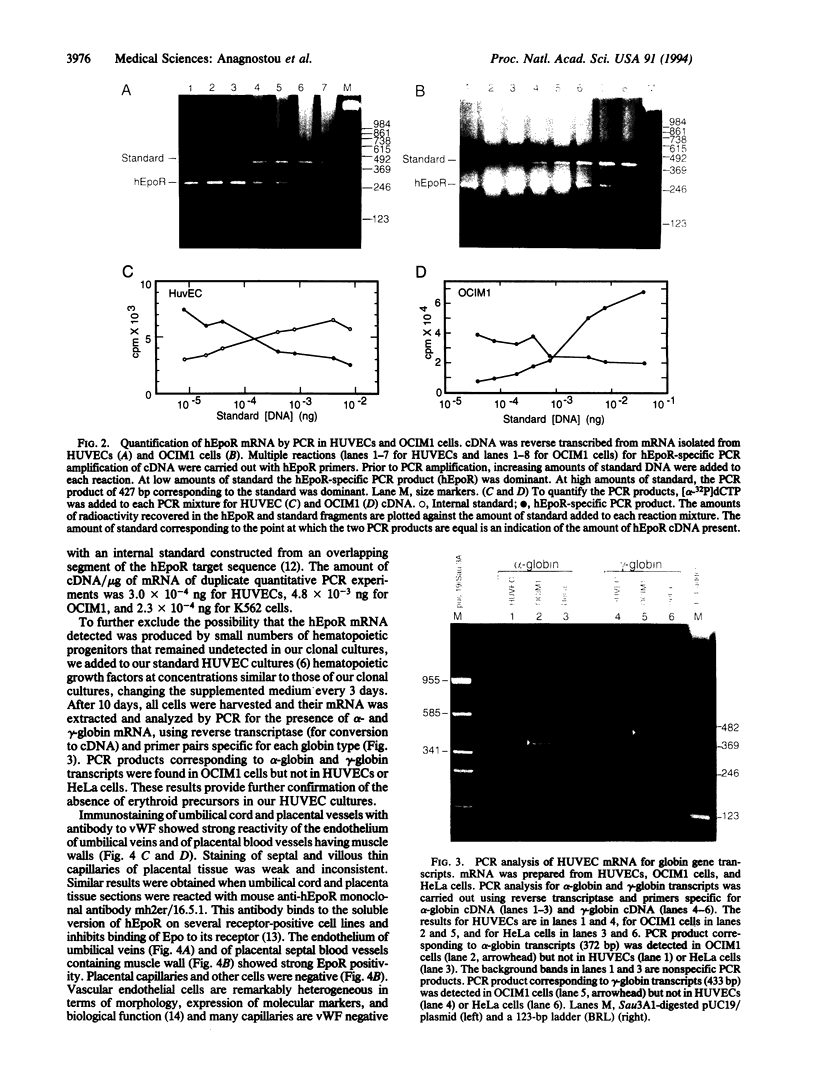
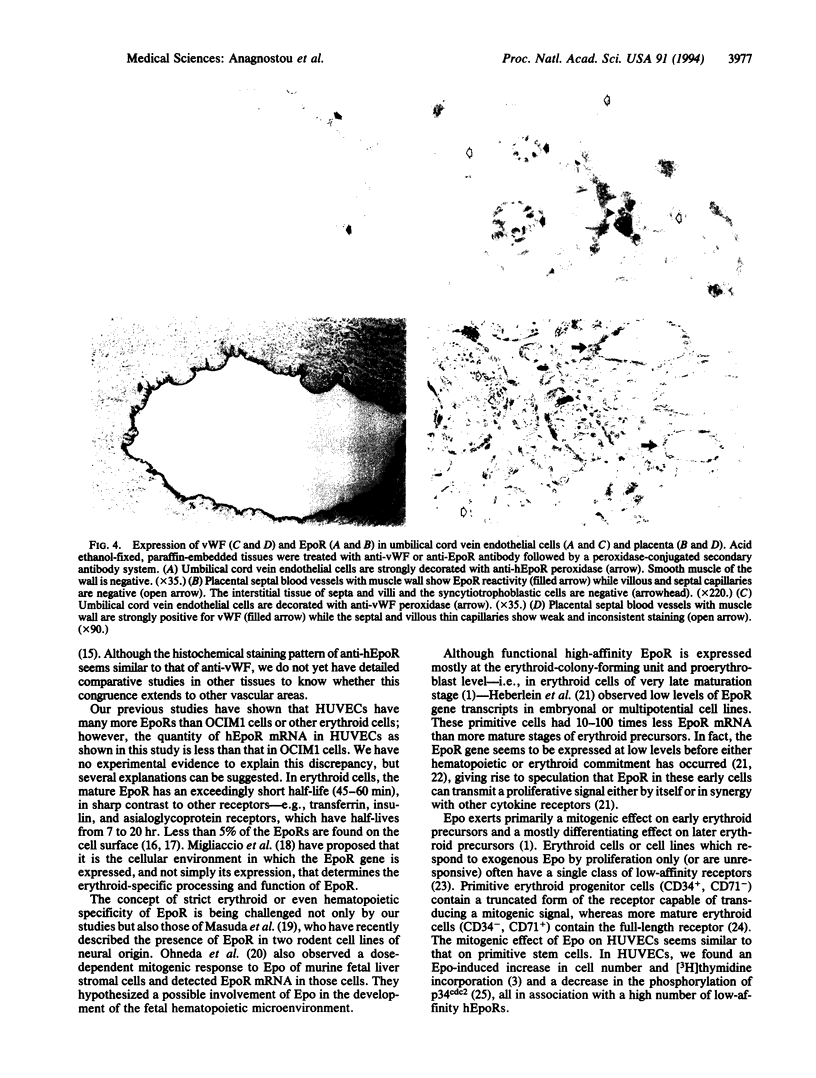
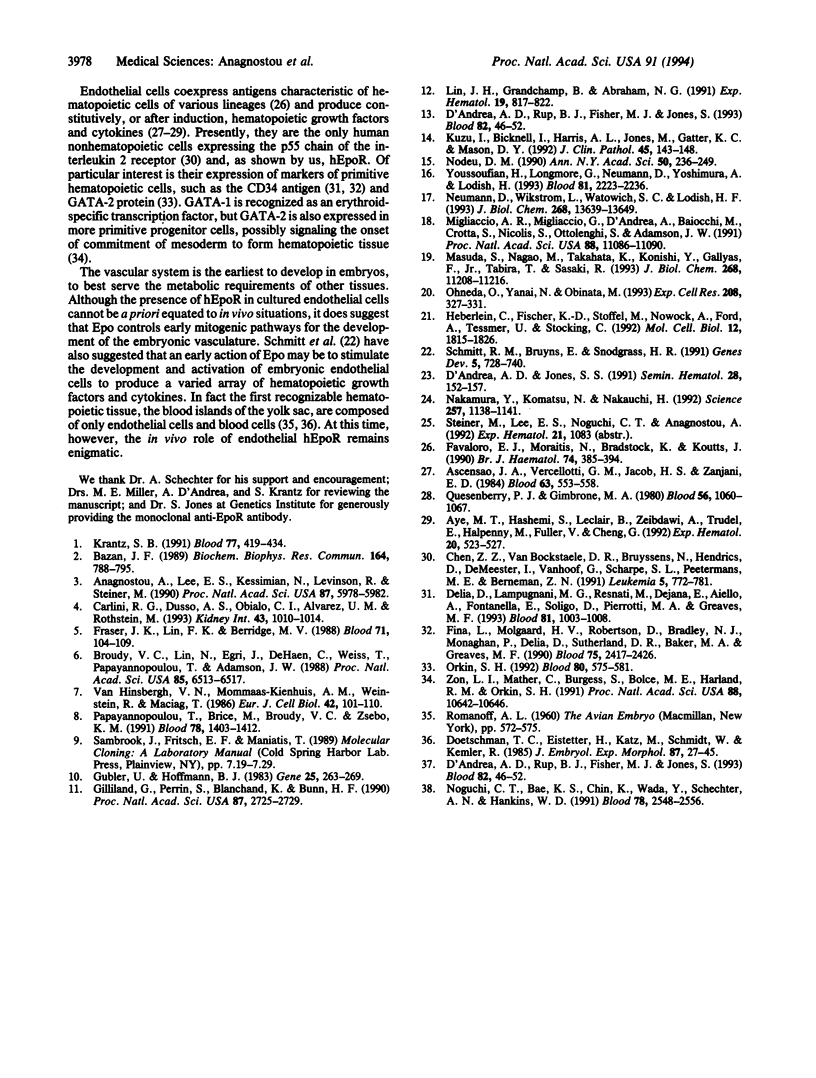
Images in this article
Selected References
These references are in PubMed. This may not be the complete list of references from this article.
- Anagnostou A., Lee E. S., Kessimian N., Levinson R., Steiner M. Erythropoietin has a mitogenic and positive chemotactic effect on endothelial cells. Proc Natl Acad Sci U S A. 1990 Aug;87(15):5978–5982. doi: 10.1073/pnas.87.15.5978. [DOI] [PMC free article] [PubMed] [Google Scholar]
- Ascensao J. L., Vercellotti G. M., Jacob H. S., Zanjani E. D. Role of endothelial cells in human hematopoiesis: modulation of mixed colony growth in vitro. Blood. 1984 Mar;63(3):553–558. [PubMed] [Google Scholar]
- Aye M. T., Hashemi S., Leclair B., Zeibdawi A., Trudel E., Halpenny M., Fuller V., Cheng G. Expression of stem cell factor and c-kit mRNA in cultured endothelial cells, monocytes and cloned human bone marrow stromal cells (CFU-RF). Exp Hematol. 1992 May;20(4):523–527. [PubMed] [Google Scholar]
- Bazan J. F. A novel family of growth factor receptors: a common binding domain in the growth hormone, prolactin, erythropoietin and IL-6 receptors, and the p75 IL-2 receptor beta-chain. Biochem Biophys Res Commun. 1989 Oct 31;164(2):788–795. doi: 10.1016/0006-291x(89)91528-3. [DOI] [PubMed] [Google Scholar]
- Broudy V. C., Lin N., Egrie J., de Haën C., Weiss T., Papayannopoulou T., Adamson J. W. Identification of the receptor for erythropoietin on human and murine erythroleukemia cells and modulation by phorbol ester and dimethyl sulfoxide. Proc Natl Acad Sci U S A. 1988 Sep;85(17):6513–6517. doi: 10.1073/pnas.85.17.6513. [DOI] [PMC free article] [PubMed] [Google Scholar]
- Carlini R. G., Dusso A. S., Obialo C. I., Alvarez U. M., Rothstein M. Recombinant human erythropoietin (rHuEPO) increases endothelin-1 release by endothelial cells. Kidney Int. 1993 May;43(5):1010–1014. doi: 10.1038/ki.1993.142. [DOI] [PubMed] [Google Scholar]
- Chen Z. Z., Van Bockstaele D. R., Buyssens N., Hendrics D., De Meester I., Vanhoof G., Scharpé S. L., Peetermans M. E., Berneman Z. N. Stromal populations and fibrosis in human long-term bone marrow cultures. Leukemia. 1991 Sep;5(9):772–781. [PubMed] [Google Scholar]
- D'Andrea A. D., Jones S. S. Activation of the erythropoietin receptor in stable lymphoid and myeloid transfectants. Semin Hematol. 1991 Apr;28(2):152–157. [PubMed] [Google Scholar]
- D'Andrea A. D., Rup B. J., Fisher M. J., Jones S. Anti-erythropoietin receptor (EPO-R) monoclonal antibodies inhibit erythropoietin binding and neutralize bioactivity. Blood. 1993 Jul 1;82(1):46–52. [PubMed] [Google Scholar]
- D'Andrea A. D., Rup B. J., Fisher M. J., Jones S. Anti-erythropoietin receptor (EPO-R) monoclonal antibodies inhibit erythropoietin binding and neutralize bioactivity. Blood. 1993 Jul 1;82(1):46–52. [PubMed] [Google Scholar]
- Delia D., Lampugnani M. G., Resnati M., Dejana E., Aiello A., Fontanella E., Soligo D., Pierotti M. A., Greaves M. F. CD34 expression is regulated reciprocally with adhesion molecules in vascular endothelial cells in vitro. Blood. 1993 Feb 15;81(4):1001–1008. [PubMed] [Google Scholar]
- Doetschman T. C., Eistetter H., Katz M., Schmidt W., Kemler R. The in vitro development of blastocyst-derived embryonic stem cell lines: formation of visceral yolk sac, blood islands and myocardium. J Embryol Exp Morphol. 1985 Jun;87:27–45. [PubMed] [Google Scholar]
- Favaloro E. J., Moraitis N., Bradstock K., Koutts J. Co-expression of haemopoietic antigens on vascular endothelial cells: a detailed phenotypic analysis. Br J Haematol. 1990 Apr;74(4):385–394. doi: 10.1111/j.1365-2141.1990.tb06324.x. [DOI] [PubMed] [Google Scholar]
- Fina L., Molgaard H. V., Robertson D., Bradley N. J., Monaghan P., Delia D., Sutherland D. R., Baker M. A., Greaves M. F. Expression of the CD34 gene in vascular endothelial cells. Blood. 1990 Jun 15;75(12):2417–2426. [PubMed] [Google Scholar]
- Fraser J. K., Lin F. K., Berridge M. V. Expression and modulation of specific, high affinity binding sites for erythropoietin on the human erythroleukemic cell line K562. Blood. 1988 Jan;71(1):104–109. [PubMed] [Google Scholar]
- Gilliland G., Perrin S., Blanchard K., Bunn H. F. Analysis of cytokine mRNA and DNA: detection and quantitation by competitive polymerase chain reaction. Proc Natl Acad Sci U S A. 1990 Apr;87(7):2725–2729. doi: 10.1073/pnas.87.7.2725. [DOI] [PMC free article] [PubMed] [Google Scholar]
- Gubler U., Hoffman B. J. A simple and very efficient method for generating cDNA libraries. Gene. 1983 Nov;25(2-3):263–269. doi: 10.1016/0378-1119(83)90230-5. [DOI] [PubMed] [Google Scholar]
- Heberlein C., Fischer K. D., Stoffel M., Nowock J., Ford A., Tessmer U., Stocking C. The gene for erythropoietin receptor is expressed in multipotential hematopoietic and embryonal stem cells: evidence for differentiation stage-specific regulation. Mol Cell Biol. 1992 Apr;12(4):1815–1826. doi: 10.1128/mcb.12.4.1815. [DOI] [PMC free article] [PubMed] [Google Scholar]
- Krantz S. B. Erythropoietin. Blood. 1991 Feb 1;77(3):419–434. [PubMed] [Google Scholar]
- Kuzu I., Bicknell R., Harris A. L., Jones M., Gatter K. C., Mason D. Y. Heterogeneity of vascular endothelial cells with relevance to diagnosis of vascular tumours. J Clin Pathol. 1992 Feb;45(2):143–148. doi: 10.1136/jcp.45.2.143. [DOI] [PMC free article] [PubMed] [Google Scholar]
- Lin J. H., Grandchamp B., Abraham N. G. Quantitation of human erythroid-specific porphobilinogen deaminase mRNA by the polymerase chain reaction. Exp Hematol. 1991 Sep;19(8):817–822. [PubMed] [Google Scholar]
- Masuda S., Nagao M., Takahata K., Konishi Y., Gallyas F., Jr, Tabira T., Sasaki R. Functional erythropoietin receptor of the cells with neural characteristics. Comparison with receptor properties of erythroid cells. J Biol Chem. 1993 May 25;268(15):11208–11216. [PubMed] [Google Scholar]
- Migliaccio A. R., Migliaccio G., D'Andrea A., Baiocchi M., Crotta S., Nicolis S., Ottolenghi S., Adamson J. W. Response to erythropoietin in erythroid subclones of the factor-dependent cell line 32D is determined by translocation of the erythropoietin receptor to the cell surface. Proc Natl Acad Sci U S A. 1991 Dec 15;88(24):11086–11090. doi: 10.1073/pnas.88.24.11086. [DOI] [PMC free article] [PubMed] [Google Scholar]
- Nakamura Y., Komatsu N., Nakauchi H. A truncated erythropoietin receptor that fails to prevent programmed cell death of erythroid cells. Science. 1992 Aug 21;257(5073):1138–1141. doi: 10.1126/science.257.5073.1138. [DOI] [PubMed] [Google Scholar]
- Neumann D., Wikström L., Watowich S. S., Lodish H. F. Intermediates in degradation of the erythropoietin receptor accumulate and are degraded in lysosomes. J Biol Chem. 1993 Jun 25;268(18):13639–13649. [PubMed] [Google Scholar]
- Noguchi C. T., Bae K. S., Chin K., Wada Y., Schechter A. N., Hankins W. D. Cloning of the human erythropoietin receptor gene. Blood. 1991 Nov 15;78(10):2548–2556. [PubMed] [Google Scholar]
- Ohneda O., Yanai N., Obinata M. Erythropoietin as a mitogen for fetal liver stromal cells which support erythropoiesis. Exp Cell Res. 1993 Sep;208(1):327–331. doi: 10.1006/excr.1993.1253. [DOI] [PubMed] [Google Scholar]
- Orkin S. H. GATA-binding transcription factors in hematopoietic cells. Blood. 1992 Aug 1;80(3):575–581. [PubMed] [Google Scholar]
- Papayannopoulou T., Brice M., Broudy V. C., Zsebo K. M. Isolation of c-kit receptor-expressing cells from bone marrow, peripheral blood, and fetal liver: functional properties and composite antigenic profile. Blood. 1991 Sep 15;78(6):1403–1412. [PubMed] [Google Scholar]
- Quesenberry P. J., Gimbrone M. A., Jr Vascular endothelium as a regulator of granulopoiesis: production of colony-stimulating activity by cultured human endothelial cells. Blood. 1980 Dec;56(6):1060–1067. [PubMed] [Google Scholar]
- Schmitt R. M., Bruyns E., Snodgrass H. R. Hematopoietic development of embryonic stem cells in vitro: cytokine and receptor gene expression. Genes Dev. 1991 May;5(5):728–740. doi: 10.1101/gad.5.5.728. [DOI] [PubMed] [Google Scholar]
- Youssoufian H., Longmore G., Neumann D., Yoshimura A., Lodish H. F. Structure, function, and activation of the erythropoietin receptor. Blood. 1993 May 1;81(9):2223–2236. [PubMed] [Google Scholar]
- Zon L. I., Mather C., Burgess S., Bolce M. E., Harland R. M., Orkin S. H. Expression of GATA-binding proteins during embryonic development in Xenopus laevis. Proc Natl Acad Sci U S A. 1991 Dec 1;88(23):10642–10646. doi: 10.1073/pnas.88.23.10642. [DOI] [PMC free article] [PubMed] [Google Scholar]
- van Hinsbergh V. W., Mommaas-Kienhuis A. M., Weinstein R., Maciag T. Propagation and morphologic phenotypes of human umbilical cord artery endothelial cells. Eur J Cell Biol. 1986 Oct;42(1):101–110. [PubMed] [Google Scholar]






